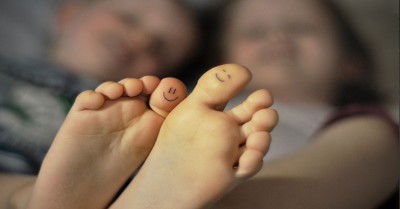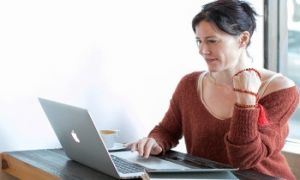A child being barefoot can stimulate a variety of senses for children. The feeling of cool prickly grass in the shade, the warm soft grass in the sun, the gritty concrete path, the stones that prick their toes, expanding and bending their toes to grip to run faster. It gives children a sense of different textures under their feet and it helps their feet develop naturally.
Here are some ways children can benefit from being barefoot and how you facilitate the process.
Good for the feet
Physical benefits of going barefoot include stronger muscles, more nerve connections as well as better walking alignment among children. The more toddlers and young kids walk without shoes or ridge support, the more stimulation their legs, ankles and feet receive. This in turn builds better arch, bone and muscle strength besides making ligament more flexible and reducing chances of developing flat feet.
Enriches sensory experiences
The human feet have a dense network of nerve endings all of which carry messages about the temperature, texture, density, stability and other physical properties of the surface we walk on. As children practise barefoot walking, their brains get better at receiving, interpreting and organizing the variety of sensory inputs received from the feet. Shoes on the other hand create an artificial barrier between surfaces and the feet with their sensory receptors.
Encourage your learners to walk on different surfaces like carpet, tiles and floorboard along with sand, mud, grass and water. Invite them to relish the tickly sensation of tiny grass shoots beneath their feet or splashing through puddles to make a rainy day interesting. Such a varied sensory diet helps the brain expand its neural pathways leading to better cognition in the years to come. At the same time, the sensory inputs sent by the feet to the brain helps them feel their natural environment and learn about the physical characteristics of surfaces. As they get older, children learn which surfaces to avoid like prickly or slippery ones. However, in an early education setting, you can check the playground or activity areas for sharp or potentially hazardous objects so as to avoid the possibility of injury to little feet.
Supports development
As children use their feet to negotiate physical spaces and explore their world, they get better at developing spatial awareness. Shoes interfere with this natural process by constricting movement and artificially moulding tender feet to shoe shapes. Barefoot walking on the other hand helps children develop a natural gait along with promoting balance, postural stability and coordination.
Offers soothing experiences
Emotional regulation is yet another aspect of barefoot learning. When a toddler is feeling anxious or an over-responsive child needs to calm down, digging the feet deep in a sand tray can be very soothing. Make sure that the child has access to water and towels to clean up or wipe off when they are ready to join their friends.
A study has shown that children who spend most of their time barefoot have increased motor skills and are better at jumping and balancing scientists say.
This study is published in the journal "Frontiers in Pediatrics". It assessors the relevance of growing up with shoes vs barefoot, in motor performance such as jumping, balancing and sprinting during the different stages of child development.
For more information on the benefits: Children Going Barefoot In An Early Childhood Setting
Reference:
Benefits On Why Your Child Should Play Barefeet, Children's Chiropractic Australia



 As an Educator in Australia, your pay rate falls under the Children’s Services Award 2010. This award states the minimum amount that an employer can
As an Educator in Australia, your pay rate falls under the Children’s Services Award 2010. This award states the minimum amount that an employer can When working as a qualified Early Childhood Teacher (with a university degree) within a service, your rate of pay will come from the Educational Services
When working as a qualified Early Childhood Teacher (with a university degree) within a service, your rate of pay will come from the Educational Services When working as a Diploma Qualified Educator your pay rate is from the Children's Services Award 2010. This Award states your minimum rate of pay
When working as a Diploma Qualified Educator your pay rate is from the Children's Services Award 2010. This Award states your minimum rate of pay When working as a Cert 3 Qualified Educator, your pay rate is from the Children's Services Award 2010. This Award states your minimum rate of
When working as a Cert 3 Qualified Educator, your pay rate is from the Children's Services Award 2010. This Award states your minimum rate of Educational Leaders play a crucial role in their early childhood service by ensuring that the educational program aligns with best practices and supports the holistic
Educational Leaders play a crucial role in their early childhood service by ensuring that the educational program aligns with best practices and supports the holistic In early childhood education and care, ratios are more than a technicality—they are a frontline safeguard. Every child deserves responsive supervision, emotional connection, and developmental
In early childhood education and care, ratios are more than a technicality—they are a frontline safeguard. Every child deserves responsive supervision, emotional connection, and developmental With the new national child safety reforms kicking in on 1 September 2025, early childhood services like yours have a real opportunity to lead the
With the new national child safety reforms kicking in on 1 September 2025, early childhood services like yours have a real opportunity to lead the Here’s a comprehensive Mobile Phone and Smart Watch Policy tailored for early childhood education and care (ECEC) services in Australia, aligned with the latest 2025
Here’s a comprehensive Mobile Phone and Smart Watch Policy tailored for early childhood education and care (ECEC) services in Australia, aligned with the latest 2025 The Sea of Fish Challenge is a national initiative that invites children, educators, families, and communities to create and display fish artworks as a symbol
The Sea of Fish Challenge is a national initiative that invites children, educators, families, and communities to create and display fish artworks as a symbol Across the early childhood education and care sector, educators are sounding the alarm: current staffing ratios are insufficient to deliver safe, meaningful, and developmentally appropriate
Across the early childhood education and care sector, educators are sounding the alarm: current staffing ratios are insufficient to deliver safe, meaningful, and developmentally appropriate


